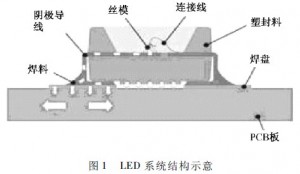The thermal transmission process of super high power LED lights:
As for normal LED lamps, LED chips are the source of heat. Heat will be transmitted within the entire lamp in three ways: conduction, convection and thermal radiation, in which thermal conduction makes the biggest contribution. Thus when technicians design the cooling section for a certain lamp, they will attempt to improve the thermal conductivity of each section with it.

Feature above is a typical structure for LED system. The thermal conductivity is basically determined by the thermal resistances between LED, circuit board and the air. There are three main problems within this part:
- Thermal resistance of LED components determines whether heat can be successfully transmitted into bases. Thermal resistance can be reduced by improving packaging technique, choosing suitable materials.
- Reducing thermal resistance between LED chips and circuit boards. Normally, it will be determined by materials of circuit boards, distances between LED chips and circuit boards, distributions of resistors on circuit boards and the connection of LED chips and circuit boards.
- If the thermal resistance between circuit boards and the air is too large, the collective heat will increase the working temperature of the entire lamps, even though all of the heat generated by LED chips were completely transmitted from LED chips into circuit boards.
In follow sections, we are going to give a small discussion on how to improve the thermal conducting capacities of super high power LED lights though these three respects.
Thermal radiation of LED chips and LED STREET LIGHT.
Most of the heat generated by PN junction will be transmitted though bases, glues and heat sinks. The simplest way is to increase thermal conductivities of them, and meanwhile increase the contact area (which can also raise thermal conductivities). In consideration of space restrictions and cost of production, the improvement in this aspect is rather limited. Among them, glues are most likely to be changed. Designers tend to use glues which have small paste thickness, like heat conducting glue, conductive silver paste and tin slurry. These three materials are typically used as LED chip glues. Among them, heat conducting glue has a relatively low thermal conductivity, conductive silver paste has better thermal conductivity and also paste strength, but it is not the best glues, since it will generate a large amount of heat by itself as well as send out toxic metals (lead). Compare with the former two materials, tin slurry is the most suitable LED chip glues, both in heat conductivity and in electric conductivity.
